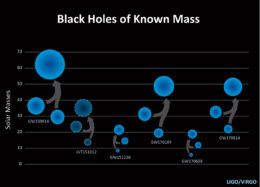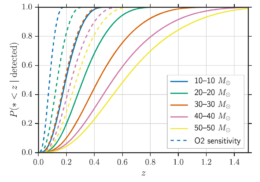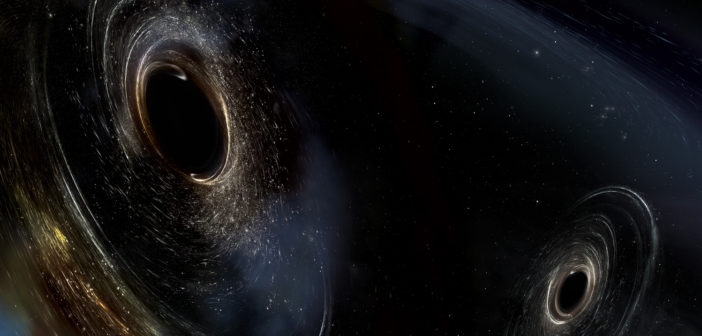The advent of gravitational-wave astrophysics has made possible the study of elusive cosmic phenomena — like the mysterious merging of stellar-mass black holes.
When Black Holes Meet

As of November 15, 2017, six black-hole mergers have been discovered via gravitational waves. [LSC/LIGO/Caltech/Sonoma State (Aurore Simonnet)]
Beyond just collecting individual merger events, we can now explore whether or not the rate at which black hole mergers occur has evolved over the course of cosmic time. The merger rate reflects the underlying star formation rate as well as the particulars of stellar evolution. Ultimately, understanding how the merger rate has changed can help us learn how black-hole binaries form.
How can we tell whether or not the rate of binary black-hole mergers has evolved with redshift? A team led by Maya Fishbach (University of Chicago) aimed to extract this information from the first six binary black-hole detections from LIGO/Virgo.

The cumulative probability distribution of detected black-hole binaries depends on black hole mass, detector sensitivity (with the dashed lines indicating a more sensitive detector), and the underlying redshift distribution. Evolution of the merger rate with redshift would shift these curves — which demonstrate the case of a uniform redshift distribution — to the left or right. [Fishbach et al. 2018]
LIGO Provides a Listening Ear
One challenge is that the redshift distribution of black-hole binaries that we observe from LIGO/Virgo isn’t just a function of the underlying redshift distribution — it’s also a function of the mass distribution. Since mergers of more massive black holes generate “louder” signals and are more likely to be detected, a binary black-hole population with more massive members will generate more detections at high redshift than a population with fewer massive members.
To remedy this, Fishbach and collaborators used models of realistic redshift distributions to fit the redshift and the two component masses simultaneously. Based on the six available binary black-hole detections, Fishbach and collaborators find that the observations are consistent with a merger rate that is constant in redshift.
There does appear to be a slight decrease in the merger rate density with increasing redshift, but the authors caution that this could arise if the detections of the “quieter” mergers are published later; an artificially large proportion of “louder” events could skew the redshift distribution toward low-redshift events.
Looking Ahead to Future Detections

Merger rate density as a function of redshift for two redshift parameterizations. Both redshift models are consistent with a constant merger rate, which is indicated by the dotted line. Click to enlarge. [Fishbach et al. 2018]
They find that with a few hundred binary black-hole detections per year — an estimate based off of the expected improvements to LIGO/Virgo sensitivity — any deviations from a constant merger rate should be detectable within a few years. Exciting developments to come!
Citation
Maya Fishbach et al 2018 ApJL 863 L41. doi:10.3847/2041-8213/aad800

1 Comment
Pingback: A body in a bath; a truck on a body. – Notes on Campus